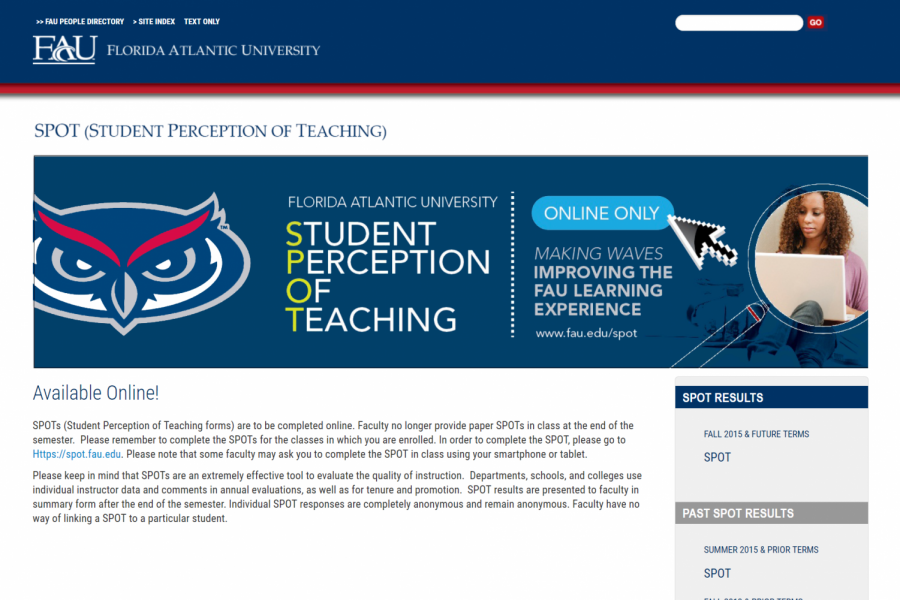SPOTs FAQs
What the Student Perception of Teaching evaluations are and why FAU wants you to take them.
February 1, 2018
Every semester you’re asked to fill out the Student Perception of Teaching survey. Yet, you aren’t told how FAU uses them.
From the evaluation’s history to why the university considers them important, we give a breakdown of everything SPOTs.
What is a SPOT evaluation?
Public universities have always needed insight into how university faculty members are performing in the classroom. Different schools have different names for these evaluations, but essentially all are surveys designed for students to give feedback on their teachers’ performance.
While not mandatory, SPOTs are available to take online at the end of every semester. Teachers are encouraged by administration to have their students take the survey.
SPOTs have nine total survey questions: six multiple choice and three short answer. Students respond to the first five by selecting: Completely Agree, Somewhat Agree, Somewhat Disagree, and Completely Disagree.
- Did they cover what was was stated in the course objectives?
- Did they communicate ideas effectively?
- Did they give useful feedback on coursework?
- Did they encourage students to think critically?
- Did they show respect for students?
- Rate your instructor’s overall teaching effectiveness in this course: Excellent, Very Good, Good, Fair, and Poor.
- What did you like most about this course?
- How could this course be improved?
- Additional comments and suggestions.
Who can see the results?
While students’ answers to the first six questions are available to the public online, their answers to the final three are withheld by the university.
“Generally speaking, publishing student comments is not an accepted best practice for the evaluation of teaching,” said FAU assistant provost for Academic Operations and Planning James Capp. “First, it would be difficult to protect student privacy and anonymity, as identifiable information may be included in the comments. Also, FAU prefers to analyze student comments using standard qualitative methods.”
Although, teachers can view the anonymous responses to all nine questions.
Capp continued: “The institution shares comments with instructors and their supervisors to ensure that they can address unique concerns on a case-by-case basis.”
How many students fill out SPOT evaluations?
Just 58 percent of FAU’s 30,000 student population complete the survey on average, according to Capp.
How does FAU use the student survey?
The sixth SPOT question, “Rate your instructor’s overall teaching effectiveness,” is used to help judge teachers’ job performance, according to the Promotion and Tenure Portfolio Guidelines for Tenure Track Faculty for 2017-18.
This applies to job reviews carried out by the university’s Promotion and Tenure Committees. Possible promotions and tenure — a form of job security offering academic freedom and certain protections from being fired — are taken into consideration if a teacher consistently performs well and receives praise via SPOTs.
What’s the history behind SPOTs?
FAU started SPOTs back in 2002. Online SPOT data is available as far back as 2005. But up until four years ago, the evaluations consisted of a longer print format handed out in class.
FAU’s Faculty Senate voted in 2014 to move SPOTs online to cater to the increase in online and blended courses.
“The conversation regarding online SPOTs revolved around accessibility,” Capp said. ”The move was due to the increased number of fully online and hybrid courses at FAU. The online SPOT could meet the needs of any course regardless of delivery mode.”
After hearing from an assessment committee, the Senate voted in 2015 to shorten the number of survey questions from 21 to the six they felt were most important, according to exercise science professor and former Faculty Union President Robert Zoeller.

The assessment committee decided to decrease the question number to increase the response rate. They felt that five were duplicate questions and that another 10 “didn’t offer additional information at the expense of greatly lengthening the evaluation and thus likely diminishing student response rate,” a letter from the committee states.
However, when SPOTs were administered via paper, the response rate was 66 percent. Today, that number has dropped 8 percent, according to Capp.
How do SPOTs compare to RateMyProfessors?
Richard Freishtat, teaching evaluations researcher and director of the University of California Berkeley Center for Teaching and Learning, said that if SPOT evaluations allowed students to view each others’ comments anonymously like review site RateMyProfessors, they’d be more likely to fill them out.

FAU only publishes the numerical responses to SPOT evaluations online, not the short answer responses.
Freishtat asked, “What incentive do students have to take the surveys, or read them if they can’t view what their colleagues are saying?”
What does FAU think of the evaluations?
Student Body President Emily Lawless has mixed feelings regarding the online evaluations.

“I do feel they are enough because if you wanted to condemn your professor you could and if you wanted to praise them, you could,” Lawless wrote in an email. “For the professors who are mediocre and I don’t really have an opinion about it becomes hard because I don’t really have anything to say, so the SPOTs is not effective to me.”
She continued: “[Students won’t fill them out] unless they are receiving extra credit, or if they have feedback they want to provide.”
Alternatively, assistant provost Capp said via email that SPOTs are an “extremely effective tool to evaluate the quality of instruction.”
Zoeller questioned the validity of the shortened online version of SPOT evaluations and said they’re not an evaluation of teachers.
“It’s called Student Perception of Teaching, it’s their perception,” Zoeller said. “My concern I raised when they shortened the form: ‘Are these valid questions?’ We have not subjected this survey to any kind of validation process. There are, for people who’ve designed surveys, validation processes.”
He added: “If we’re going to do this, let’s make sure we have a valid document.”
Joe Pye is the SPOTs special issue writer for the University Press. For information regarding this or other stories, email [email protected] or tweet him @jpeg3189.
















